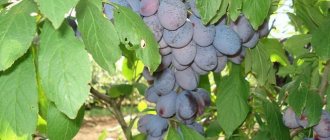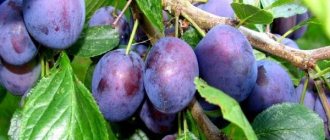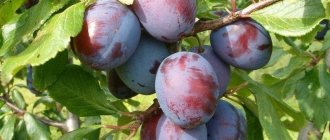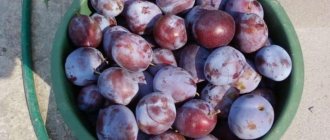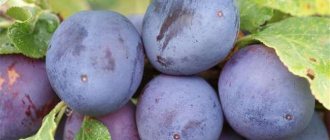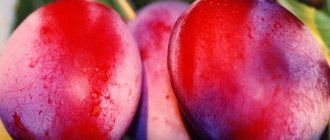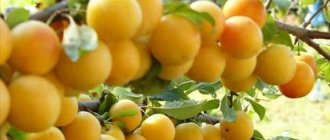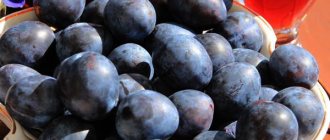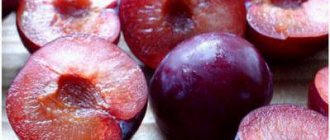Description of the variety
Eurasia 21 is an early plum variety. It is characterized by high winter hardiness of the tree, root system and flower buds. The fruits ripen in the first ten days of August.
The tree is tall. An adult plant reaches a height of 6 m. The crown is of medium density, semi-spreading. The bark of the trunk and branches is brown-gray. Grown on weak growing rootstocks. The leaf blade is medium, elongated, pointed. The edges have small serrations. The leaves are dark green, dense. Blooms abundantly, flowers are small.
The tree of the Eurasia 21 variety has a semi-spreading crown of a mosaic structure
The fruits are round, burgundy in color, and quite large in size. Average weight: 23–30 g. Thin skin has a strong waxy coating. The pulp is yellow-orange, sweet and sour. The structure is soft, slightly loose. The aroma is rich. The medium-sized bone is difficult to separate from the pulp.
The appearance of the fruits of the Eurasia 21 variety is very attractive
Calorie content and nutritional value of fruits
Eurasia 21 fruits are low-calorie and contain many useful substances and vitamins. Often found in the diet, as well as in children's menus.
| Element | Content per 100 g |
| The nutritional value | |
| Calorie content | 47 kcal |
| Alimentary fiber | 1.1 g |
| Organic acids | 2.7 g |
| Sahara | 7.02 g |
| Solids | 14.60 g |
| Vitamins | |
| A (RE) | 0.1 mg |
| PP | 0.6 mg |
| B1 | 0.06 mg |
| B2 | 0.04 mg |
| E | 0.6 mg |
| WITH | 11.78 mg |
| Microelements | |
| Calcium | 20 mg |
| Magnesium | 9 mg |
| Sodium | 18 mg |
| Phosphorus | 20 mg |
| Macronutrients | |
| Iron | 0.5 mg |
| Iodine | 4 mcg |
| Chromium | 4 mcg |
| Fluorine | 2 mcg |
Advantages and disadvantages of the variety (table)
| Advantages | Flaws |
| high yield | tree height and size |
| precocity | fruit drop |
| high winter hardiness of the tree, flower buds and root system | cracking of the fruit skin due to lack of moisture |
| resistance to diseases and pests | low transportability of fruits |
| large fruits | loose fruit pulp |
| long shelf life |
Plum storage and transportability
Due to the loose pulp, Eurasian fruits may be damaged during transportation. That is why it is recommended to either immediately put them into processing or remove them unripe. In the refrigerator, at zero temperature, they retain commercial quality for three weeks.
If you're not a fan of tall trees, then Eurasia 21 is not for you. All other disadvantages of this variety are not so significant as to refuse the extremely productive plum. With proper care, the tree will produce about 50 kg of large plums every summer.
0
0
Copy link
Pollinators
Plum Eurasia 21 is a self-sterile variety (the pollen is non-viable). For a good ovary it needs additional cross-pollination. To do this, they use special pollen mixtures or plant plums nearby, the flowering period of which coincides with the flowering of Eurasia 21. These are varieties of domestic plums such as Renklod Soviet, Renklod collective farm, Mayak, Renklod fruitful.
The best pollinators for the plum variety Eurasia 21 (photo gallery)
The Renklod Soviet variety is distinguished by high consumer qualities of fruits
The productive Renklod variety begins to bear fruit in its fourth year
The Renklod kolkhoz variety is distinguished by its early ripening period.
The Mayak variety is characterized by high productivity
History of selection and region of breeding
“Eurasia 21” was developed by scientists from the Voronezh Agrarian University. It was obtained through complex interspecific hybridization.
American, East Asian, Chinese and domestic plums, as well as cherry plum and apricot plum (Simona) took part in the formation of the variety.
The authors of “Eurasia 21” are breeders A.G. Turovtsev and A.N. Venyaminov.
After state tests in 1986, the variety was entered into the State Register and recommended for cultivation in the Central Black Earth regions of Russia. Also, “Eurasia 21” can often be found in gardens in the middle zone and the Moscow region.
Landing
Seedlings are planted in dry, windless weather. For planting you will need the following tools:
- pruning shears or garden shears;
- bayonet shovel;
- garden hose or bucket.
Boarding time
The most favorable time for planting is early spring (before the buds open). Trees are planted after the snow has completely thawed and frost has stopped.
How to prepare the soil
It is better to plant plums in medium loamy and clayey areas with neutral acidity. Planting pits are prepared in the fall or spring three weeks before planting the seedlings.
- In autumn, a hole is formed with a diameter of 1 m and a depth of 80 cm. The dug up soil is mixed with 250 g of superphosphate, 30–40 g of potassium sulfate, 200 g of dolomite flour and 3 buckets of humus.
- In the spring, the pit is filled with a soil mixture from the top layer of turf soil, 2 buckets of rotted compost, 30 g of urea, 200 g of ash.
In enriched soil, trees take root and develop better. After such preparation in the first 2 years, no additional fertilizing is required.
Selection of planting material
High-quality planting material can be purchased at a nursery or specialized retail outlet. Zoned seedlings tolerate changing conditions more easily and take root better. Signs of a healthy tree:
- well-developed root system, roots at least 10 cm;
- absence of mechanical damage to the bark, dry branches and roots;
- the vaccination site is clearly visible.
Seedlings with open and closed root systems are suitable for planting.
A full-fledged two-year-old plum seedling should have a pronounced conductor (trunk) and 3–5 skeletal branches 50–70 cm long, directed evenly in different directions
Step by step planting process
First, the seedling is soaked for several hours in garden mash or in water. If there are green leaves, they are torn off.
- In the prepared place, dig a hole with a diameter 2 times larger than the diameter of the root system, 40–50 cm deep.
- The soil at the bottom is loosened and a hillock is formed.
- A wooden stake is inserted into the middle.
- A seedling is placed in the hole. The root collar should rise 5 cm above the level of the site.
- The roots are covered with earth, lightly compacted. The tree is tied with string or twine to a wooden peg.
- Make a hole with a diameter of 50 cm. Water with 2-3 buckets of water.
- Mulch with peat or wood shavings.
When planting several trees, you should follow the planting pattern - at least 3 m between trees and 4.5 m between rows.
Planting and fertilizing plums (video)
How to choose the right Eurasian seedling?
The best option for purchasing a seedling is to contact a nursery. When buying planting material on the market, from unknown sellers, you risk not only purchasing a completely different variety than you expected, but also infecting your garden with some fungal or viral disease.
Rules for choosing seedlings:
- The root system must be well developed. The length of the roots is from 10 cm. There should be no damage, traces of fungus or rot.
- The bark is intact, without damage. No dry branches.
- The vaccination site should be clearly visible. The graft is located just above the root collar.
Optimal parameters for a seedling:
- age – 1-2 years;
- height – up to 150 cm;
- trunk thickness – 1.3 cm;
- number of branches – 3-4 pieces.
Even 3-year-old seedlings should not be taken - they take root worse than 1-2 year-old ones.
Care
The stability and yield level of the Eurasia 21 plum depends not only on the climatic conditions of cultivation, but also on the care of the crop. This variety requires systematic feeding, watering, proper pruning, and protection from diseases and pests.
Feeding system
Fertilizing plums is one of the important aspects of caring for the crop. Properly selected products and timely feeding significantly affect the quality of the fruit and the development of the plant.
Plum fertilizer (table)
| Season | Type of feeding | Period | Fertilizers |
| Spring | root | before flowering (April) | When digging a circle around the trunk, 20–30 g of ammonium nitrate are evenly applied (per 1 sq. m of area). |
| during the flowering period (May) | Sodium humate solution (3 tablespoons per 10 liters of water) or mineral solution (2 tablespoons urea, 2 tablespoons potassium sulfate per 10 liters of water) or 300 g of Berry fertilizer per 10 liters of water. Watering - 25 liters per tree. | ||
| after flowering | Nitrophoska solution (3 tablespoons per 10 liters of water) or Giant berry fertilizer (300 g per 10 liters of water). Watering - 30 liters per tree. | ||
| Summer | foliar | first, third ten days of June | Urea solution (2 tbsp per 10 l of water) or Ideal (2 tbsp per 10 l of water). Consumption: 10 liters of solution per tree. |
| Autumn | root | September 20–30 | 2 tbsp. l. potassium chloride or sulphide, 3 tbsp. l. superphosphate per 10 liters of water. Watering 1 tree - 20 liters. |
| Liming the soil. When digging, 300–400 g of lime, chalk, ash are scattered or watered with solutions. Raw materials are selected according to the type of soil. Liming is carried out every 4 years or as needed. | |||
| While digging the earth around the trunk, 100 g of superphosphate and 120 g of potassium magnesium are added. |
Watering
Plum is a rather moisture-loving crop that does not tolerate drought very well. Young plants should be watered once every 10 days. Consumption: 30–40 liters of water per tree. Mature plums are watered twice a month - 60 liters per tree.
Important! The main sign of lack of moisture is cracked fruits. With excess moisture, yellowing of the leaves and death of the tops is observed.
The frequency of watering is adjusted depending on weather conditions and precipitation.
Trimming
Pruning of plum trees is carried out annually. The most favorable period is spring (late March - early April). The procedure is carried out with special tools - a garden saw and pruning shears.
The main stages of spring pruning:
- crown thinning. Remove excess branches, as well as branches growing deeper;
- shortening. Last year's growth is trimmed.
- During spring pruning, a sparsely tiered crown is formed during the first 5 years. To do this, leave 5–7 well-developed strong branches that extend from the trunk at an angle of 45–50 degrees. Later, the angle is corrected using ropes. The first tier consists of three branches. Two are located on the same level, the third is slightly higher. The second tier is formed from two branches located at different levels. The best option is that the main and skeletal branches are located at a distance of 20 cm from each other and directed in different directions.
Plum trees in the garden, when growing naturally, tend to form a large number of branches that are susceptible to fractures and frost damage, as a result the plant bushes heavily and the yield decreases
- Summer pruning is carried out in June. It is carried out in the first two years after planting. At this time, the side shoots are shortened by 20 cm, the premature shoots by 15 cm. The central conductor is not cut off.
- Autumn pruning is carried out in mid-September. Remove dry and damaged branches and trim the top. Fast-growing shoots are shortened by a third. The main stages of autumn pruning:
- during primary autumn pruning, the main trunk is shortened by 1/3, the remaining branches and shoots - by 2/3;
- rejuvenation of old and thickened trees. Completely remove small and large dried branches. If they move away from the trunk, cut them into a ring;
- carry out regulatory pruning of young and old trees. Branches growing at an acute angle and deep into the crown are completely removed. The main skeletal branches are shortened.
Important! All cut branches are burned; cut areas with a diameter of more than 2 cm must be treated with garden varnish.
Other Important Points
Each fruit crop has its own nuances when growing. And plum is no exception.
Key Features:
- winter care;
- thinning;
- branch support.
- Plum requires careful care in winter. Young seedlings must be wrapped in burlap or paper. A thick layer of snow is poured onto the circle around the trunk, trampling it with your foot. Snow is carefully shaken off the branches of mature trees.
- To obtain regular harvests, it is recommended to thin out annually. It is carried out twice per season (during the formation of the ovary and at the beginning of fruit ripening).
- Often the tree branches droop greatly due to the number of fruits. To prevent them from being damaged or broken, the branches are supported with special sticks. The supporting part of these devices should be wrapped in soft material, so friction and mechanical damage to tree branches are eliminated.
When and how to harvest?
The first plum harvest from Eurasia is harvested in the 3rd year, and the older the tree, the greater the yields will be. The branches of a mature tree bend under the weight of the fruit. To prevent branches from breaking, they are supported with supports.
Eurasia 21 bears fruit early - the first plums can be harvested at the end of July or at the beginning of August. They do not ripen together - in waves, so harvesting is extended into 3-4 stages.
If you pick the fruits a little unripe - 7-10 days before they are ready, they will not lose any of their taste. They will not only reach good condition safely, but will also be stored better.
Winter tree protection
Despite its good frost resistance, the Eurasia plum requires pre-winter agrotechnical measures. Thanks to them, the tree safely survives the winter without freezing or becoming prey for rodents.
The procedure for preparing a plum tree for winter:
- Removing leaves from the trunk circle.
- Water-recharging irrigation – 80 l.
- Loosening and sprinkling with mulch - shavings, rotted sawdust, peat are suitable. Mulch layer – 10-12 cm.
- Removing dead bark and growing moss.
- A similar procedure for skeletal branches.
- Whitewashing peeling areas. The solution is prepared from 10 liters of water, 0.5 kg of copper sulfate, 2.5 kg of chalk or lime, and 200 g of wood glue.
- The cleaned and whitened wood is wrapped in burlap, agrofibre or paper. To protect against rodents, the tree trunk is wrapped in fine metal mesh.
Protecting the tree from pests and diseases
Plum Eurasia 21 has average resistance to pests and diseases, so timely preventive treatment should be carried out to prevent their occurrence.
Chemical pest control products (table)
| Period | Pests | Preparations for protection, treatment period | Prevention |
| Before flowering |
| Digging the earth around the trunk. The drug Cyanox - once. | Urea solution 3% – once a month. |
| plum aphid | Spark - once | ||
| After flowering |
| Karbofos 10%, trichlorometaphos-3 - once, again after 7-10 days if a pest is present. |
|
| plum aphid | Planriz, Reakom, Skor - once, again after 14 days if a pest is present. | ||
| Growing season |
| Benzophosphate - once, again 5-6 days after flowering. | Urea solution 5%, Aktelik - once a month. |
| plum aphid | Decis - once, repeat treatment after 10-12 days if the pest is not destroyed. | ||
| After harvest | rodents | Absolon, BoyKot. The grain is poured into the burrows. | Rodents are repelled by the following scattered around the tree trunk:
|
Chemical remedies for diseases (table)
| Period | Diseases | Protective means, treatment period | Prevention |
| Before flowering |
| Avarta, Fitosporin - sprayed twice with an interval of 10-12 days. |
|
| After flowering |
| Skor, Horus - treated twice with an interval of 10 days. |
|
| Growing season |
| Horus, Fitosporin - treated twice with an interval of 7-10 days. |
|
Main diseases and pests of plum (photo gallery)
The plum sawfly can destroy most of the plum crop
Plum aphids are common in all areas where the plant is cultivated
Plum codling moth caterpillars feed and develop in the fruits of any crop
In severe forms of fruit rot, whole garlands of rotten plum fruits can be observed
Clusterosporiosis is a widespread disease of plums.
The process of planting plum seedlings Eurasia
When the hole and seedling are prepared, planting begins. Procedure:
- The bottom of the pit is carefully loosened and a hill is formed.
- A support for the seedling - a wooden peg - is placed in the middle of the hill.
- The seedling is placed on the top of the hill, straightening the roots.
- Sprinkle the roots with soil, tamping it with your hand.
- The root collar should be at a distance of 3-5 cm from the surface of the earth.
- The seedling is tied to a peg.
- A depression d = 50 cm is made around the trunk to water the tree. Watering norm is 3 buckets of water.
- Sprinkle the tree trunk circle with mulch.
When planting several plum seedlings, leave 3 m between adjacent ones and 4.5 m between rows.
Harvesting
The first fruits appear 3–4 years after planting. The average yield of one tree under 7 years old reaches 18–28 kg, and over 8 years old – 30–40 kg.
Under favorable conditions, the maximum yield of an adult tree is 50 kg.
Under favorable pollination conditions, the yield of plum Eurasia 21 is very high
The fruits begin to ripen at the end of July. They reach harvesting maturity in the first half of August. The crop is harvested in several stages by hand.
To extend shelf life, fruits are removed 5–7 days before ripeness.
Fruit use and storage
Plum Eurasia 21 is a table variety. The fruits are consumed fresh; in home cooking, jam, dried fruits, etc. are prepared from plums. In industrial processing, they are used in the production of juices with pulp, purees, and confiture.
You can make jam, jam and other preparations from plums of the Eurasia 21 variety.
Fresh plums are stored in the refrigerator at a humidity of 80% and a temperature of 0 degrees for 15–20 days. Longer storage may cause the flesh to darken.
Plums are also stored frozen. In this case, the shelf life increases to 7 months. The disadvantage of this method is the loss of taste. The fruits become more sour.
Characteristics of plum
Eurasia is distinguished by a successful combination of unpretentiousness and high quality fruits. Among the stone fruits, there are few such unpretentious and productive crops as the plum, and Eurasia is one of its best representatives.
Main agrotechnical characteristics of the Eurasia 21 variety:
| Characteristics | Parameters/description |
| Productivity | young tree – 20 kg adult – 40-50 kg record – 100 kg |
| Ripening time | early ripening |
| Precociousness | harvest - in the 3rd-4th year |
| Pollination | self-sterility |
| Frost resistance | average, up to minus 20-25 °C |
| Resistance to diseases and pests | average, needs timely processing |
| Drought resistance | low, without watering the leaves turn yellow and the fruits fall off |
Reviews from gardeners
Eurasia 21 is a very winter-hardy variety. But it requires a pollinator variety because it is self-sterile. The berries are large, round, sweet, the stone is easily separated.
drum
https://dacha.wcb.ru/lofiversion/index.php?t5271.html
Eurasia 21 is a powerful, strong tree, without damage to the trunk. Various other breeds and varieties can be grafted onto it.
Amateur
https://dacha.wcb.ru/lofiversion/index.php?t5271.html
What you definitely shouldn’t plant is Volga Beauty, Eurasia 21. Although the fruits of these varieties are tasty, the harvest is rare.
Kolyadin Roman
https://forum.prihoz.ru/viewtopic.php?f=37&t=1266&start=630
Eurasia blooms very early, when it is still relatively cold. For me it bloomed profusely every spring, but did not set fruit. In addition to her, there were also Renklod Kolkhozny, Volzhskaya Beauty, and Mirnaya on the site. Once there was an early, hot spring and with the same pollinators, the entire plum was in fruit. This was the first and last harvest. After abundant fruiting, it immediately froze.
Yakimov
https://dacha.wcb.ru/index.php?showtopic=48768
Until this and partly the previous spring, my “Eurasia” bloomed first, even before the damsons. And it stood completely empty.
alex123
https://dacha.wcb.ru/index.php?showtopic=48768
The plum variety Eurasia 21 is popular among gardeners. The tree is easy to care for and frost-resistant. Large fruits are stored fresh for a long time, which makes it possible to use them in commercial activities. Based on Eurasia 21, breeders are developing new varieties of plums and also using it for rootstock.
- Author: Ekaterina Krushina
I love nature and the world around us. I love spending time at my dacha. Copywriting is not a job for me, but rather a lifestyle. Rate this article:
- 5
- 4
- 3
- 2
- 1
(0 votes, average: 0 out of 5)
Share with your friends!
Area of application of berries
Eurasia is an early table variety intended for fresh consumption. Plums with juicy, tender pulp are an excellent dessert for summer. But this variety is also good in preparation - large soft fruits make excellent jam and jam, juices with pulp, and sauces.
Although Eurasia is not Hungarian, prunes are made from it, however, it turns out to be sour. But this plum is not suitable for freezing - when frozen, the fruits lose their taste and become watery. Compotes are also not made from Eurasian fruits - their pulp is too loose, and the compote can turn out cloudy.

